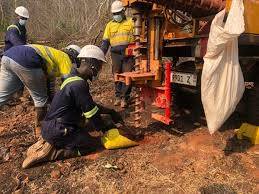Mpasaso Nyahini Bauxite Debate
The Mpasaso Nyahini Forest Bauxite: Balancing Economic Development and Environmental Conservation
Introduction:
Globally recognized for its rich biodiversity and ecological importance, the Mpasaso Nyahini Forest in Ghana has recently become a focal point of debate due to the potential extraction of bauxite deposits within its boundaries. This forest, located in the Ashanti Region, represents a delicate balance between economic development and environmental conservation. As stakeholders engage in discussions about the future of the Mpasaso Nyahini Forest, it is crucial to assess the potential impacts of bauxite mining and explore sustainable approaches that preserve the forest's unique ecosystem.
The Mpasaso Nyahini Forest:
Spanning approximately 12,000 hectares, the Mpasaso Nyahini Forest boasts a remarkable variety of flora and fauna. It is home to numerous endangered species, including the Togo Slippery Frog and the Nimba Otter Shrew, and serves as a crucial habitat for migratory birds. The forest also plays a significant role in local communities' livelihoods, providing resources such as timber, non-timber forest products, and ecotourism opportunities.
Bauxite Mining Potential:
Ghana is renowned for its significant bauxite deposits, which hold immense economic potential. The extraction and exportation of bauxite have the capacity to generate revenue, create jobs, and boost industrial development. Recognizing this, the Ghanaian government has explored the possibility of tapping into the bauxite resources within the Mpasaso Nyahini Forest through the proposed Integrated Aluminum Industry.
Environmental Concerns:
However, the proposed bauxite mining project raises legitimate concerns about its potential impact on the forest ecosystem. Deforestation, habitat destruction, soil erosion, and water pollution are some of the primary environmental risks associated with mining activities. Furthermore, the loss of biodiversity and disruption of the delicate ecological balance in the Mpasaso Nyahini Forest could have far-reaching consequences for both local communities and global conservation efforts.
Balancing Economic Development and Environmental Conservation:
Achieving a balance between economic development and environmental conservation is of utmost importance when considering the future of the Mpasaso Nyahini Forest. It is crucial to explore sustainable alternatives and adopt responsible mining practices that mitigate environmental impacts. This includes measures such as proper land rehabilitation, reforestation initiatives, and strict adherence to environmental regulations.
Additionally, stakeholders should consider alternative approaches to bauxite extraction, such as sourcing bauxite from other locations or implementing more advanced mining technologies that minimize ecological disruption. Investment in renewable energy sources and non-extractive industries can also provide viable economic opportunities for the region while preserving the forest's ecological integrity.
Community Engagement and Conservation:
Meaningful participation and engagement of local communities in decision-making processes are paramount. Their knowledge and perspectives can contribute to finding sustainable solutions that address both economic and environmental concerns. Implementing benefit-sharing mechanisms, such as revenue sharing and capacity-building initiatives, can ensure that local communities directly benefit from mining activities while also safeguarding their traditional practices and livelihoods.
Conclusion:
The Mpasaso Nyahini Forest represents an intricate dilemma between the potential economic benefits of bauxite mining and the urgent need for environmental conservation. It is crucial that all stakeholders, including the government, mining companies, local communities, and environmental organizations, come together to seek sustainable solutions that preserve the forest's biodiversity and ecosystem services.
By adopting responsible mining practices, exploring alternative extraction methods, and engaging in meaningful dialogue, it is possible to strike a balance between economic development and environmental conservation. Ultimately, the fate of the Mpasaso Nyahini Forest will demonstrate our commitment to sustainable development and the protection of our natural heritage for future generations


